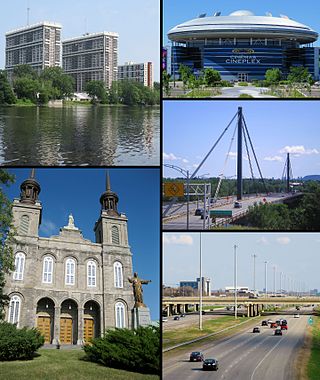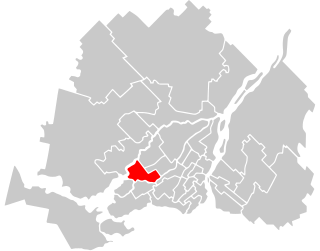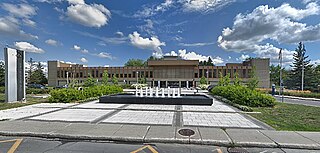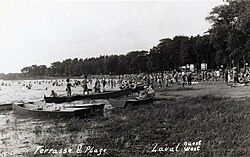
Laval is a city in Quebec, Canada. It is in the southwest of the province, north of Montreal. It is the largest suburb of Montreal, the third-largest city in the province after Montreal and Quebec City, and the thirteenth largest city in Canada, with a population of 443,192 in 2021.

Île Jésus is a river island in southwestern Quebec, separated from the mainland to the north by the Rivière des Mille Îles, and from the Island of Montreal to the south by the Rivière des Prairies. It is the second-largest island in the Hochelaga Archipelago, and the fourth most populous island in Canada, with more than 420,000 residents as of 2016.

Terrebonne is an off-island suburb of Montreal, in southwestern Quebec, Canada. It is located in the North Shore region of the Montreal area, north of Laval across the Rivière des Mille-Îles.

Saint-Eustache is an off-island suburb of Montreal, in western Quebec, Canada, west of Montreal on the north shore of the Rivière des Mille Îles. It is located 35 km (22 mi) northwest of Montreal.

Mirabel is a suburb of Montreal, located on the North Shore in southern Quebec.

Laval—Les Îles is a federal electoral district in Quebec, Canada, that has been represented in the House of Commons of Canada since 2004.

Sainte-Anne-des-Plaines is a city in southwestern Quebec, Canada, 40 km northwest of the city of Montreal in the Thérèse-De Blainville Regional County Municipality, in the region of Laurentides. Its population was 14,990 during the census of 2014.

Rosemère is an affluent suburb of Montreal, in southwestern Quebec, Canada on the north shore of the Rivière des Mille Îles in the Thérèse-De Blainville Regional County Municipality. The town is noted for its green look, due to the high density of trees. Some wooded areas in the town have been left intact as the town has grown around them. Homes are mostly upscale, varying from renovated cottages to unique character homes. It is almost entirely residential, with no significant industries. Boulevard Curé-Labelle, the town's main commercial artery, is lined up by suburban shops and shopping malls, the largest of which is Place Rosemère.

Lorraine is an affluent off-island suburb of Montreal, in southwestern Quebec, Canada on the north shore of the Rivière des Mille-Îles in the Thérèse-De Blainville Regional County Municipality. There are no industries and only a very limited commercial district ; almost all houses are of the detached type. Furthermore, a large portion of the town territory is set aside as wild forest ; some bike/ski trails run through it. The town is divided into two areas, Uptown and Downtown. These two areas are also delimited by Quebec freeway A-640, and are only joined together by the main street overpass.

Ahuntsic-Cartierville is a borough (arrondissement) of the city of Montreal, Quebec, Canada. The borough was created following the 2002 municipal reorganization of Montreal. It comprises two main neighbourhoods, Ahuntsic, a former village annexed to Montreal in 1910 and Cartierville, a town annexed to Montreal in 1916.

Le Vésinet is a suburban commune in the Yvelines department in the Île-de-France region in north-central France. It is a part of the affluent outer suburbs of western Paris, 16.4 km (10.2 mi) from the centre of Paris.

Chomedey is a district in the southwest of the city of Laval and was a separate municipality until the municipal mergers in 1965.

Auteuil is a district of Laval in Quebec, Canada. It is delimited in the north-west by the Rivière des Mille-Îles, north-east by Saint-François, south-east by Duvernay, south by Vimont and south-west by Sainte-Rose.
Sainte-Dorothée is a district in Laval, Quebec. It was a separate city until the municipal mergers on August 6, 1965.

Fabreville is a district in Laval, Quebec. It was a separate city until the municipal mergers on August 6, 1965.

Sainte-Rose is a district in Laval, Quebec. It was incorporated as a village in 1850, and was a separate town until the municipal mergers on August 6, 1965 which amalgamated all the municipalities on Île Jésus into a single City of Laval.

Bois-des-Filion is an off-island suburb of Montreal, located in Quebec, Canada, to the north of Montreal.

Pointe-Calumet is a municipality in the Canadian province of Quebec. The municipality is located within the Deux-Montagnes Regional County Municipality in the Laurentides region. It is situated about 30 minutes northwest of Montreal. Its population as of the 2006 Canadian Census is just over 6 000.

Saint-Joseph-du-Lac is a municipality in the Laurentides region of Quebec, Canada, part of the Deux-Montagnes Regional County Municipality.
The Centre de services scolaire de Laval (CSSDL) is a French-language school service centre in the Canadian province of Quebec. It is headquartered in Laval. As of 2011, the board of the predecessor, Commission scolaire de Laval, managed fifty-two primary schools, fourteen secondary schools, eight professional development centres, and three adult education centres in Laval.





















